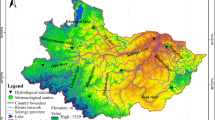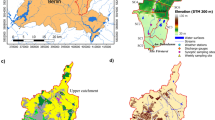Abstract
The Thac Ba reservoir serves as a critical supply of water for residents in Hanoi's downstream region, who rely on it for their livelihood. Recent changes in land use have resulted in a greater input of silt and nutrients into the environment. A large number of modeling studies have not been carried out because of the challenges in obtaining data from both China and Vietnam. The reservoir is located inside an international drainage basin that connects China and Vietnam. On the basis of the findings of the calibrated and verified SWAT model on streamflow and sediment, we provide this paper. On the basis of monthly data gathered from 1992 to 2003, the model’s performance was extremely excellent in terms of the coefficient of determination (R2) and the Nash–Sutcliffe coefficient (NSE), with R2 = 0.885 and NSE = 0.914 for precipitation and R2 = 0.826 and NSE = 0.849 for sediment, respectively. It was less accurate (NSE = 0.628) but remained dependable in the daily streamflow calibration case study. Based on climate change predictions for Vietnam, four scenarios were designed and assessed for this study. The case study also provides a quantitative illustration of how successfully GIS and SWAT can function together when the amount of meteorological data available is restricted. These findings will be useful in the administration of water and soil conservation initiatives in the future.





















Similar content being viewed by others
References
Abbaspour KC, Yang J, Maximov I, Siber R, Bogner K, Mieleitner J, Zobrist J, Srinivasan R (2007) Modelling hydrology and water quality in the pre-alpine/alpine Thurwatershed using SWAT. J Hydrol 333(2–4):413–430. https://doi.org/10.1016/j.jhydrol.2006.09.014
Abraham LZ (2007) Calibration and validation of SWAT hydrologic model for Meki Watershed, Ethiopia. In: Proceedings of Tropentag 2007: conference on international agricultural research for development. University of Kassel-Witzenhausen and University of Göttingen, 9–11 October 2007
Akhavana S, Abedi-Koupaia J, Mousavia S-F, Afyunib M, Eslamiana S-S, Abbaspourc KC (2010) Application of SWAT model to investigate nitrate leaching in Hamadan-Bahar Watershed, Iran. Agric Ecosyst Environ 139:675–688. https://doi.org/10.1016/j.agee.2010.10.015
ASTER GDEM Validation Team (2011) ASTER global digital elevation model version 2—summary of validation results. METI & NASA. http://www.jspacesystems.or.jp/ersdac/GDEM/ver2Validation/Summary_GDEM2_validation_report_final.pdf
Ballatore TJ (2011) Delineating lake drainage basins in GIS. Lake Basin Action Network (LBAN), Moriyama, Japan
Beven K (1989) Changing ideas in hydrology—the case of physically-based models. J Hydrol 105:157–172. https://doi.org/10.1016/0022-1694(89)90101-7
Box GEP, Jenkins GM (1976) Time series analysis: forecasting and control. Holden-Day, San-Francisco. ISBN-13: 978-0816211043
Esayas Y (2010) Evaluating the impact of land use land cover change on soil erosion and runoff using SWAT model at TikurWuha watershed. Masters dissertation, Addis Ababa University, Addis Ababa, Ethiopia
FAO/IIASA/ISRIC/ISSCAS/JRC (2012) Harmonized World Soil Database (version 1.2). FAO, Rome, Italy and IIASA, Laxenburg, Austria. http://www.fao.org/soils-portal/soil-survey/soil-maps-and-databases/harmonized-world-soil-database-v12/en/
Farr TG, Rosen PA, Caro E, Crippen R, Duren R, Hensley S, Kobrick M, Paller M, Rodriguez E, Roth L, Seal D, Shaffer S, Shimada J, Umland J, Werner M, Oskin M, Burbank D, Alsdorf D (2007) The Shuttle Radar topography mission. Rev Geophys 45(2):RG2004. https://doi.org/10.1029/2005RG000183
Ha NM (2009) Spatial modeling for soil erosion risk in Chay Basin, in Vietnam. In: Proceedings of the 7th FIG regional conference: spatial data serving people: land governance and the environment—building the capacity. Hanoi, Vietnam, 19–22 October 2009
Hairsine PB, Rose CW (1991) Rainfall detachment and deposition: sediment transport in the absence of flow-driven processes. Soil Sci Soc Am J 55(2):320–324. https://doi.org/10.2136/sssaj1991.03615995005500020003x
Hao F-H, Zhang X-S, Yang Z-F (2003) A distributed non-point source pollution model: calibration and validation in Yellow River basin. J Environ Sci 16(4):646–650
Hijmans RJ, Cameron SE, Parra JL, Jones PG, Jarvis A (2005) Very high resolution interpolated climate surfaces for global land areas. Int J Climatol 25:1965–1978
Hung LT, Rulli MC, Ranzi R (2010) Effect of reservoirs on sediment load in the Lo river basin (China-Vietnam). In: Proceedings of the 78th annual meeting of international commission of large dams. Hanoi, Vietnam, May 2010
IPCC (2007) The physical science basis: contribution of working group I to the fourth assessment report of the intergovernmental panel on climate change. Cambridge University Press, Cambridge, UK, New York, NY
Khoi DN, Suetsugi T (2014) Impact of climate and land-use changes on hydrological processes and sediment yield—a case study of the Be River catchment Vietnam. Hydrol Sci J 59(5):1095–1108. https://doi.org/10.1080/02626667.2013.819433
Kleijnen JPC (1995) Statistical validation of simulation models: a case study. Discussion Paper 1995-42, Tilburg University, Center for Economic Research
Kranz N, Menniken T, Hinkel J (2010) Climate change adaptation strategies in the Mekong and Orange-Senqu basins: what determines the state-of-play? Environ Sci Policy 13(7):648–659. https://doi.org/10.1016/j.envsci.2010.09.003
Legates DR, McCabe GJ Jr (1999) Evaluating the use of “goodness-of-fit” Measures in hydrologic andhydroclimatic model validation. Water Resour Res 35(1):233–241. https://doi.org/10.1029/1998WR900018
Mahmood R, Babel MS, Jia S (2015) Assessment of temporal and spatial changes of future climate in the Jhelum river basin Pakistan and India. Weather Clim Extremes 10:40–55. https://doi.org/10.1016/j.wace.2015.07.002
Moriasi DN, Arnold JG, Van Liew MW, Bingner RL, Harem RD, Veith TL (2007) Model evaluation guidelines for systematic quantification of accuracy in Watershed simulations. Trans Am Soc Agric Biol Eng 50(3):850–900
Nash JE, Sutcliffe JV (1970) River flow forecasting through conceptual models part I — A discussion of principles. J Hydrol 10(3):282–290. https://doi.org/10.1016/0022-1694(70)90255-6
Neitsch SL, Arnold JG, Kiniry JR, Williams JR (2011) Soil and water assessment tool: theoretical documentation (2009). Texas Water Resources Institute, College Station
Neitsch SL, Arnold JG, Kiniry JR, Williams JR, King KW (2002) Soil and water assessment tool (SWAT): theoretical documentation, version 2000. Texas Water Resources Institute, College Station, Texas, TWRI Report TR-191
Nguyen QM, Le TC (1990) Observation of soil erosion in Vietnam. Vietnam National University, Hanoi
Nguyen TS, Nguyen YN (2009) Applying SWAT model to simulate stream flow in Ben Hai river basin in response to climate change scenarios. VNU J Sci Earth Sci 25(3):161–167
Nguyen VD, Douglas I, McMorrow J, Lindley S, Dao K, Nguyen TB, Tran TV, Le HT, Nguyen T (2008) Erosion and nutrient loss on sloping land under intense cultivation in Southern Vietnam. Geogr Res 46(1):4–16. https://doi.org/10.1111/j.1745-5871.2007.00487.x
Nguyen TN, Nguyen TX, Pham TV, Nguyen D-T (2021) Applying the soil and water assessment tool model for integrated lake basin management in Northern Vietnam: case study of the Thac Ba Reservoir Basin. Environ Eng Sci. https://doi.org/10.1089/ees.2020.0378
Nie W, Yuan Y, Kepner W, Nash MS, Jackson M, Erickson C (2011) Assessing impacts of landuse and landcover changes on hydrology for the upper San Pedro watershed. J Hydrol 407(1–4):105–114. https://doi.org/10.1016/j.jhydrol.2011.07.012
Opere AO, Okello BN (2011) Hydrologic analysis for river Nyando using SWAT. Hydrol Earth Syst Sci 8:1765–1797. https://doi.org/10.5194/hessd-8-1765-2011
Panhalkar SS (2014) Hydrological modeling using SWAT model and geoinformatic techniques. Egypt J Remote Sens Space Sci 17(2):197–207. https://doi.org/10.1016/j.ejrs.2014.03.001
Phien T (1997) The limiting factor for agricultural cultivation on sloping land Vietnam. Conference report on the management of nutrients and water for plants slopes of North Vietnam
Ranzi R, Caronna P, Tomirotti M (2017) Impact of climatic and land use changes on river flows in the Southern Alps. Sustain Water Resour Plan. https://doi.org/10.1007/978-981-10-2051-3_3
Ranzi R (2012) Climate and anthropogenic change impact on the hydrological cycle, water management and engineering
Santhi C, Arnold JG, Williams JR, Hauck LM, Dugas WA (2001) Application of a watershed model to evaluate management effects on point and non-point source pollution. Trans Am Soc Agric Eng 44(6):1559–1570
UNESCO (2004) Catalogue of Rivers in Southeast Asia and the Pacific, UNESCO’s International Hydrological Programme (IHP). http://www.unesco.or.id/download/River-Catalogues.pdf
Van Griensven A (2005) Sensitivity, auto-calibration, uncertainty and model evaluation in SWAT2005. UNESCO, Brussels
Vezina K, Bonn F, Van CP (2006) Agricultural land-use use patterns and soil erosion vulnerability of watershed units in Vietnam’s northern highlands. Lands Ecol 21(8):1311–1325. https://doi.org/10.1007/s10980-006-0023-x
Vien TD, Lam NT, Trinh MV, Dung PT (2008) Textbook on environmental analysis of agricultural systems (in Vietnamese). Hanoi Agricultural Publishing House, Hanoi, pp 137–138
Williams JR, Berndt HD (1977) Sediment yield prediction based on watershed hydrology. Trans Am Soc Agric Biol Eng 20(6):1100–1104. https://doi.org/10.13031/2013.35710
Zhang X-S, Hao F-H, Cheng H-G, Li D-F (2003) Application of SWAT model in the upstream of the Luoheriver. Chin Geogr Sci 13(4):334–339. https://doi.org/10.1007/s11769-003-0039-y
Acknowledgements
The authors wish to thanks the Department of Physical Chemistry, School of Chemical Engineering, Hanoi University of Science and Technology for highly help in these studies.
Author information
Authors and Affiliations
Contributions
All authors contributed to the study’s conception and design. Material preparation, data collection, and analysis were performed by N-TN, D-TN. The first draft of the manuscript was written by N-TN, D-TN. All authors read and approved the final manuscript.
Corresponding author
Ethics declarations
Conflict of interests
The authors declare that they have no competing interests.
Additional information
Publisher's Note
Springer Nature remains neutral with regard to jurisdictional claims in published maps and institutional affiliations.
Rights and permissions
About this article
Cite this article
Nguyen, NT., Nguyen, DT. Evaluation of the hydrology and sediment load situations of the upper watershed of Thac Ba reservoir (Vietnam and China) under the impacts of climate changes. Model. Earth Syst. Environ. 8, 5595–5610 (2022). https://doi.org/10.1007/s40808-022-01406-6
Received:
Accepted:
Published:
Issue Date:
DOI: https://doi.org/10.1007/s40808-022-01406-6




